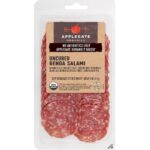Salami is a type of sausage that originates from Italy. It was traditionally made from pork but many varieties today are made with beef, venison, poultry, or other meats. It is often made of meat blended with fat, herbs, seasonings, salt, garlic, and vinegar. There are many varieties of salami that differ in how they are made. There are cooked, dry, and semi-dry salamis, as well as cured and uncured. Cured salami contains chemical additives such as nitrates or nitrites for preservation. Uncured salami relies on natural salts and flavorings for preservation. Though salami contains preservatives, how long does it really last?
Salami does go bad. Uncooked fresh salami lasts 2 hours at room temperature, 1-2 days in the refrigerator, and 1-2 months in the freezer. Cooked fresh salami lasts 3-4 days in the refrigerator opened, 2 weeks in the refrigerator unopened. Hard/dry salami lasts 6 weeks at room temperature, 3 weeks in refrigerator opened, indefinitely in refrigerator if unopened.
In this article, we will go over whether salami goes bad, discuss how to properly store it, and answer some common questions about it. We will then introduce some alternatives to salami. Let’s get started!
Contents
Different Types of Salami and How It’s Made
There are many different types of salami, such as cooked and/or smoked, dry, and semi-dry.
Cooked and/or smoked salami is made from fresh meats, which are cured, stuffed into casings, cooked in smokehouses at high temperatures, and then air dried for a short time. It has a softer texture than dry or semi-dry salami and must be refrigerated. Examples of cooked sausages include hot dogs and bologna.
Dry and semi-dry salami are fermented by bacterial growth for flavor and preservation. They may also be cultured with lactic acid. Fermentation is one of the oldest methods of preserving meats. Examples of dry salami are pepperoni and genoa. Examples of semi-dry salami are summer sausage and Lebanon bologna.
In this process, a mixture of salt, sodium nitrite, and starter culture of lactic acid bacteria is mixed with meat, placed in casings, fermented, and then dried in a carefully controlled air-drying process. This process kills harmful bacteria and takes more time.
Semi-dry salami is usually heated in smokehouses to fully cook it and partially dry it. The texture comes out semi-soft.
Does Salami Go Bad Over Time?
Yes, salami does go bad over time. The timing however, varies with different types of salami. It also varies if the salami has been cut, as it will go bad a lot faster when cut than if it remains whole. Dry salami, which can remain at room temperature, must be refrigerated as soon as it is cut because bacteria grows rapidly once it is cut.
Freeze salami if you cannot use it within the time labeled on package.
Uncooked Fresh Salami, Uncured Lasts:
- At room temperature – 2 hours
- In the refrigerator, opened or unopened – 1-2 days
- In the freezer – 1-2 months
Cooked Fresh Salami, Uncured Lasts:
- In the refrigerator, opened – 3-4 days
- In the refrigerator, unopened – 2 weeks
- In the freezer – 2-3 months
Hard/Dry Salami, Cured Lasts:
- At room temperature, unopened – 6 weeks
- In refrigerator, opened and uncut – 3 weeks
- In refrigerator, unopened and uncut – indefinitely
- In freezer – 1-2 months, but will remain safe beyond that time if kept at constant frozen temperature of 0 degrees Fahrenheit.
Does Salami Need To Be Refrigerated?
All sausage, except for dry salami, is perishable and needs refrigeration. For best results, always refrigerate salami and follow dates on packages.
Some dry salami is shelf-stable and doesn’t require refrigeration or freezing to be stored safely. These products will not have a safe handling statement, cooking directions, or keep refrigerated statement.
How Can You Tell If Salami Has Gone Bad?
Look for these signs to tell if salami has gone bad, and do not taste it if you see any of the following:
1. Change in Color
It is completely normal to see a white powdery residue on your salami. That is a good mold and is an important part of the curing process of salami. However, if you see any other color such as black, green, grey, or brown, it is time to throw it away. Those are signs of contamination from bad bacteria and it should be thrown away.
2. Change in Smell
While it may be normal for salami to smell acidic and resemble the smell of cheese, spoiled salami will smell like sewage or rotten eggs. If you smell this, throw it away.
3. Change in Texture
The texture of salami when it has gone bad will either get hard and dry or wet and slimy. Throw it away if it becomes like this.
How To Properly Store Salami
Cooked/Uncooked Fresh Salami, Uncured:
- Keep in an airtight container.
- Always store in the refrigerator, whether opened or unopened. Fresh salami does not undergo the same preservation process as hard/dry salami and will go bad quickly.
Hard/Dry Salami, Cured:
- If unopened and uncut, store in pantry for up to 6 weeks.
- If unopened and uncut, store in refrigerator indefinitely.
- If opened, store in the refrigerator in an airtight container up to 3 weeks.
- In the freezer, salami will maintain best quality 1-2 months, but will remain safe beyond that time if kept at constant frozen temperature of 0 degrees Fahrenheit.
Can You Get Sick From Eating Old Salami?
Yes, you can get sick from eating old salami. If opened and/or cut, bacteria can easily grow in salami. Most commonly, eating salami that has gone bad causes food poisoning characterized by nausea, vomiting, diarrhea, and sometimes fever, body pain, and chills. If food poisoning symptoms do not resolve after 3 days or worsen, seek medical attention immediately.
Does Salami Have Preservatives?
Yes, hard/dry salami does have preservatives in the form of nitrates and nitrites, which makes it a cured meat. Fresh salami usually does not contain these, and is called uncured. Nitrates/nitrites are added to salami for two reasons. The first reason is to preserve the color in salami so it stays pink instead of an unappetizing grey color. The second reason is to inhibit the growth of harmful bacteria such as botulism.
Alternatives To Salami
Balistreri Salami Point Loma, Rosemary & Garlic
 For all-natural salami that is made from hormone-free and antibiotic-free pork with no nitrates or nitrites added, P. Bastreri Salami Point Loma Rosemary & Garlic is the way to go. It is handcrafted artisan salami made with simple ingredients. It is low in sugar, non-GMO, keto-friendly, and most importantly with no nitrates/nitrites added. Flavor options include this rosemary and garlic option, chili flake and fennel, and little heat.
For all-natural salami that is made from hormone-free and antibiotic-free pork with no nitrates or nitrites added, P. Bastreri Salami Point Loma Rosemary & Garlic is the way to go. It is handcrafted artisan salami made with simple ingredients. It is low in sugar, non-GMO, keto-friendly, and most importantly with no nitrates/nitrites added. Flavor options include this rosemary and garlic option, chili flake and fennel, and little heat.
Applegate Organics Uncured Genoa Salami
 Applegate Organics Uncured Genoa Salami is also made with no antibiotics, no added hormones, and no nitrates/nitrites. It is free from artificial or GMO ingredients, gluten-free, dairy-free, and casein-free. This salami has a distinct flavor and softer texture than many other types of salami. It is a great addition in a charcuterie board.
Applegate Organics Uncured Genoa Salami is also made with no antibiotics, no added hormones, and no nitrates/nitrites. It is free from artificial or GMO ingredients, gluten-free, dairy-free, and casein-free. This salami has a distinct flavor and softer texture than many other types of salami. It is a great addition in a charcuterie board.
Alef Sausage All Natural Chicken Salami
Also with no nitrates or nitrites added except those naturally occurring in celery and cherry powders, Alef Sausage All Natural Chicken Salami is another great alternative to regular salami. It is made with no artificial ingredients, is gluten-free, dairy-free, and contains no MSG. It has a simple ingredient list and is lower in calories, fat, and sodium content than regular salami. It is made with 100% chicken, has a soft texture, and mild flavor from a unique blend of spices.
Alef Sausage All Natural Turkey Dry Salami
 With a deep red color and rich flavor, it is hard to tell this version is lower in fat than beef or pork salami. Alef Sausage All Natural Turkey Dry Salami is made using old-world methods and spices and has a delicious garlic finish. It is gluten-free, dairy-free, with no artificial ingredients. This option also has no nitrates or nitrites added except those naturally occurring in celery and cherry powders.
With a deep red color and rich flavor, it is hard to tell this version is lower in fat than beef or pork salami. Alef Sausage All Natural Turkey Dry Salami is made using old-world methods and spices and has a delicious garlic finish. It is gluten-free, dairy-free, with no artificial ingredients. This option also has no nitrates or nitrites added except those naturally occurring in celery and cherry powders.
Scout Hardwood Smoked Wild Pink Salmon
Wild-caught in Alaska, Scout Hardwood Smoked Wild Pink Salmon is a wonderful alternative to salami that can be enjoyed straight out of the can. It has a flaky texture and delicate smoky flavor. With only 4 ingredients, it is low in sodium, high in protein, and no sugar added. It is gluten-free, dairy-free, paleo, and ketogenic.
Related Questions
Is salami keto-friendly?
Yes, salami is keto-friendly. It contains about 0-2 grams of carbohydrates per serving.
Is salami paleo-friendly?
Some, but not all salami is paleo-friendly. For salami to be paleo-friendly, it needs to be uncured, all natural, and contain no preservatives. A lot of brands on the market are not paleo-approved. Look for uncured salami as they are more natural and contain little preservatives.
Does salami have dairy?
Yes, some salami varieties do have dairy in the form of dry milk. Read the labels and look for dairy-free alternatives if you are looking to avoid dairy in salami.
